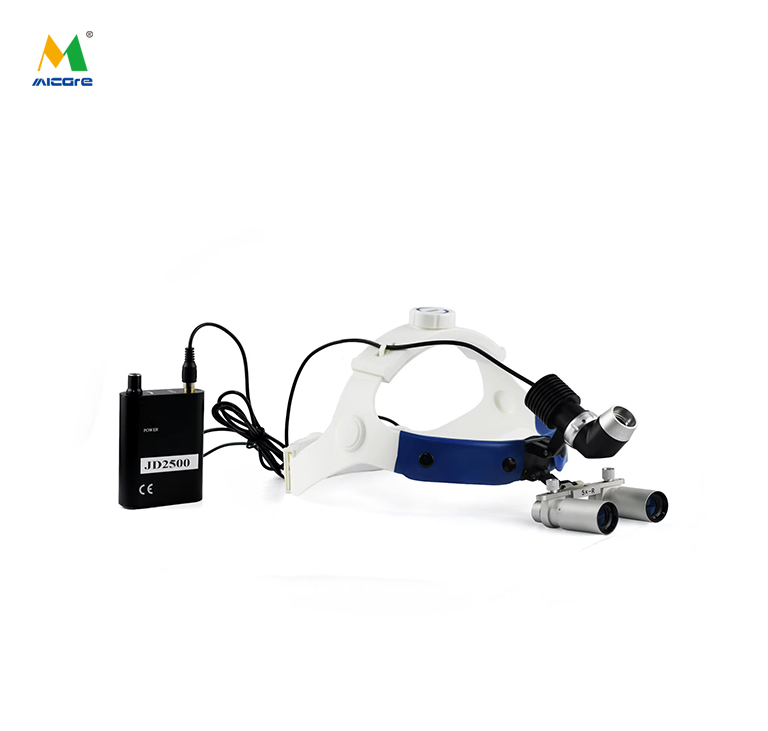Key Features to Consider When Buying Surgical Loupes with Headlight
Modern surgical systems which combine loupes with headlights create essential instruments for elimination of dark areas during medical procedures in both dental and surgical operations. Various important features need assessment to determine the optimal system that delivers high quality performance alongside comfortable usage and lasting durability.
1. Optical Quality and Magnification
Surgical loupes exist primarily to supply unobstructed precise magnified vision to the user. Key optical considerations include:
Magnification Power (2.5x–6x): Selecting magnetic power factors should align with operational requirements. General procedures need wide magnification from 2.5x to 3.5x while microsurgical work along with dental procedures require power from 4.5x to 6x.
Working Distance (30–45 cm): The headlight system requires matching surgeon postures to prevent strain in neck and back regions.
Depth of Field: The broader depth setting allows continuous focus between multiple layers of tissue without manual readjustment by the surgeon.
Anti-Reflective and Anti-Fog Coatings: Essential for maintaining clarity in humid operating environments.
2. Headlight Performance
A headlight integration requires clear and shadowless brightness for illumination which must not produce fatigue to the surgeon's eyes. Important specifications include:
Brightness (20,000–50,000 lux): Adjustable intensity for different surgical fields.
Beam Focus and Coverage: The illumination spot can be enlarged or reduced to a size between 5 and 15 cm based on lighting needs.
Color Temperature (4500K–5500K): The light design matches daylight conditions to enable proper identification of tissue differences.
Flicker-Free and Uniform Light: The equipment protects visual health during long periods of continuous operation.
3. Ergonomics and Comfort
The long duration surgeons maintain loupes while performing surgeries requires instruments that deliver optimal comfort for their wearer.
Lightweight Design (Under 300g total): Reduces strain on the nose, ears, and neck.
Balanced Weight Distribution: The weight is evenly distributed on the headlight to stop its slippage or tilting during surgery.
Adjustable Headband: The adjustable strap of the headband needs to create secure fit while avoiding both uncomfortable pressure points.
Heat Dissipation: The device needs to dissipate heat properly to keep the headlight surface at a comfortable temperature.
4. Power and Battery Life
A power system with reliability provides continuous usage throughout the entire operation.
Rechargeable Lithium-Ion Battery: The rechargeable Lithium-Ion Battery has a charge duration of 6–10 hours that enables surgery lengths spanning full days.
Quick Charging (≤2 Hours): Minimizes downtime between procedures.
Battery Indicator: The device shows notification alerts before running out of power.
Wired vs. Wireless Options: The decision between wireless and wired connections gives users either portability through wireless or uninterrupted power through wired.
5. Durability and Sterilization Compatibility
Manufactured surgical loupes need to succeed in resistant operating room environments:
Autoclavable or Chemical-Resistant Materials: The equipment needs to use materials which maintain their functionality after complete sterilization through autoclaving or chemical resistance tests.
Scratch-Resistant Lenses: Maintain optical clarity over time.
Water-Resistant Housing: Protects internal components from moisture.
6. Customization and Additional Features
Interpupillary Distance (IPD) Adjustment: Ensures proper alignment with the wearer’s eyes.
Modular Design: Allows attachment of cameras for teaching or documentation.
Red Light Mode: Useful for vascular and dermatological procedures.
Conclusion
The purchase of professional surgical loupes which integrate built-in headlight systems leads to better surgical results through increased accuracy and minimizes operator fatigue. The selection of systems should start with focusing on optical clarity combined with illumination quality and ergonomic comfort alongside durability. The combination of properly designed loupe-headlight equipment enables surgeons to enhance both their performance and product lifetime in harsh medical settings.











































